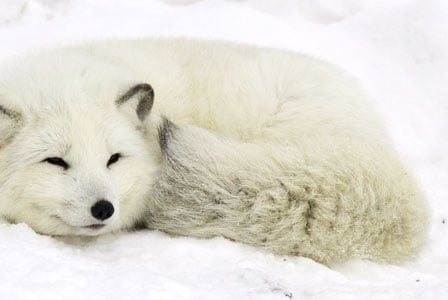
This Wildlife Wednesday, learn about the hardy – but adorable – Arctic fox, and how it could be impacted by climate change.
If there were a competition for cuteness between the Arctic fox, sea otter, and red panda, it’s anyone’s game. But at the size of a large housecat and covered in thick, fluffy white fur, the Arctic fox is pretty stiff competition.
Habitat: Arctic regions of Asia, North America, Europe, and Greenland
Arctic fox trivia
- You’ve got to be pretty tough to survive in the Arctic, where temperatures can reach a mind-boggling -50 C, and the Arctic fox is no exception. Some of its adaptations include furry soles and a giant tail to help with cover.
- They create burrows to protect themselves from the elements, and they quickly dig themselves into the snow in the case of a blizzard.
- The Arctic fox’s coat changes from white in the winter to brown or grey in the summer, to camouflage with the changing environment.
- During the summer, Arctic foxes will hunt birds, eggs, rodents such as lemmings, and fish, but in the winter when food is scare, they have been known to become scavengers, eating the remains of a polar bear’s dinner.
- Like other types of foxes, Arctic foxes will hide their food if there’s a surplus and save it for a rainy day.
- Both the male and the female Arctic fox help raise the young.
Why they’re threatened and what you can do to help
Although at one time Arctic foxes were threatened primarily by hunting (their thick white coat was very valuable in the fur trade), their main threat today is climate change.
Researchers believe that lemmings, one of the Arctic fox’s main food sources, will suffer with longer falls and an increase in thawing and freezing (two consequences of climate change in the Arctic). And when lemmings suffer, Arctic foxes suffer. Warmer temperatures also mean that red foxes (related to Arctic foxes) enter the Arctic fox’s territory, so the two compete for resources.
An additional threat to Arctic foxes is humans, although indirectly. Recent research shows that Arctic foxes often have high levels of mercury and chlorinated pesticides in their bodies, which they absorb through the environment via the fish they eat.
Therefore, we can help the Arctic fox indirectly by altering our daily habits, such as by reducing the amount of mercury we add to the environment, eating organic, and reducing our carbon footprints.

















